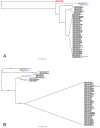Bacillus cereus Biovar Anthracis Causing Anthrax in Sub-Saharan Africa-Chromosomal Monophyly and Broad Geographic Distribution
- PMID: 27607836
- PMCID: PMC5015827
- DOI: 10.1371/journal.pntd.0004923
Bacillus cereus Biovar Anthracis Causing Anthrax in Sub-Saharan Africa-Chromosomal Monophyly and Broad Geographic Distribution
Abstract
Through full genome analyses of four atypical Bacillus cereus isolates, designated B. cereus biovar anthracis, we describe a distinct clade within the B. cereus group that presents with anthrax-like disease, carrying virulence plasmids similar to those of classic Bacillus anthracis. We have isolated members of this clade from different mammals (wild chimpanzees, gorillas, an elephant and goats) in West and Central Africa (Côte d'Ivoire, Cameroon, Central African Republic and Democratic Republic of Congo). The isolates shared several phenotypic features of both B. anthracis and B. cereus, but differed amongst each other in motility and their resistance or sensitivity to penicillin. They all possessed the same mutation in the regulator gene plcR, different from the one found in B. anthracis, and in addition, carry genes which enable them to produce a second capsule composed of hyaluronic acid. Our findings show the existence of a discrete clade of the B. cereus group capable of causing anthrax-like disease, found in areas of high biodiversity, which are possibly also the origin of the worldwide distributed B. anthracis. Establishing the impact of these pathogenic bacteria on threatened wildlife species will require systematic investigation. Furthermore, the consumption of wildlife found dead by the local population and presence in a domestic animal reveal potential sources of exposure to humans.
Conflict of interest statement
The authors have declared that no competing interests exist.
Figures



References
-
- World Organisation for Animal Health (OIE), World Health Organization (WHO), Food and Agriculture Organization of the United Nations (FAO). Anthrax in humans and animals. Fourth Edition Geneva: WHO; 2008.
Publication types
MeSH terms
Substances
LinkOut - more resources
Full Text Sources
Other Literature Sources
Medical

